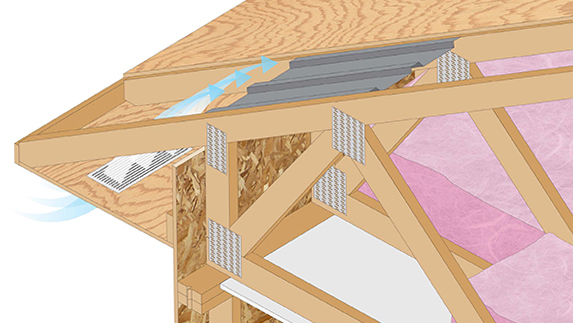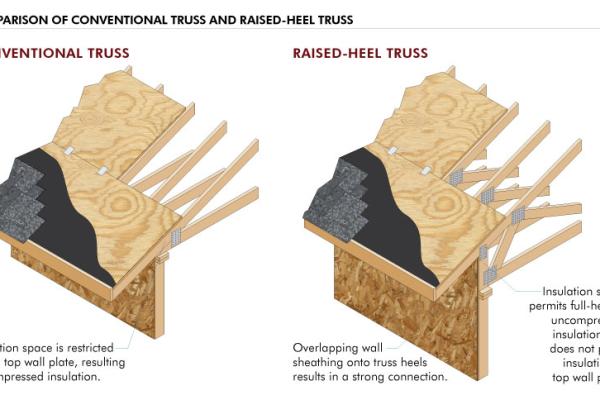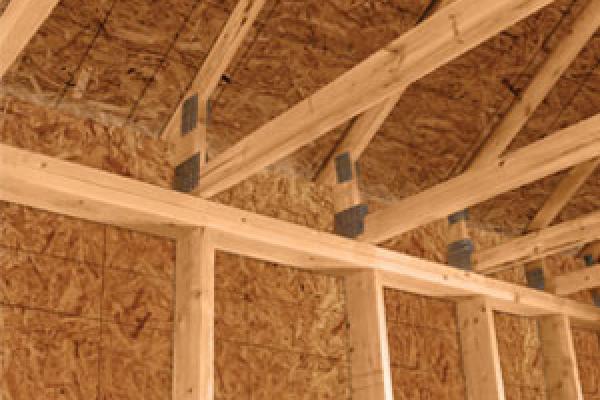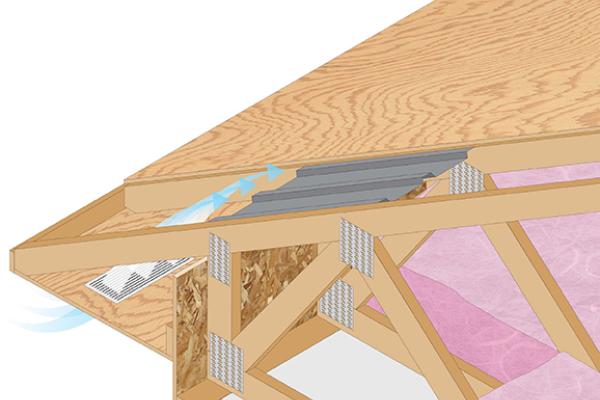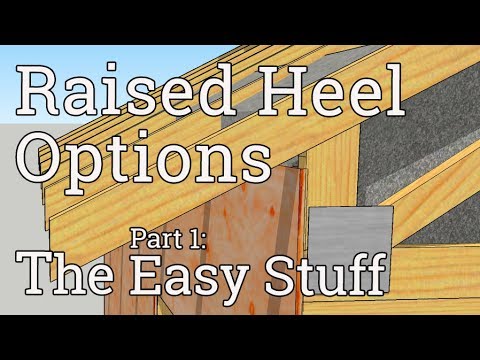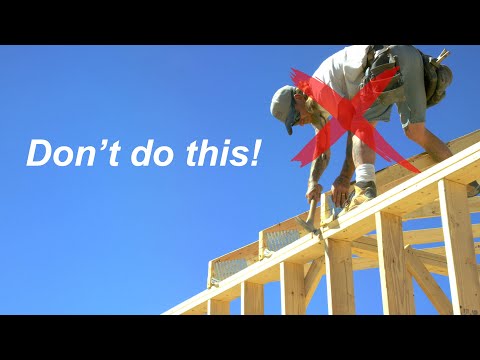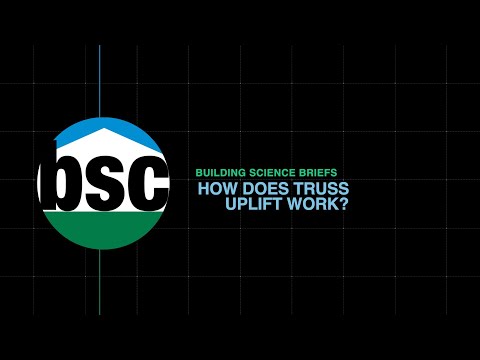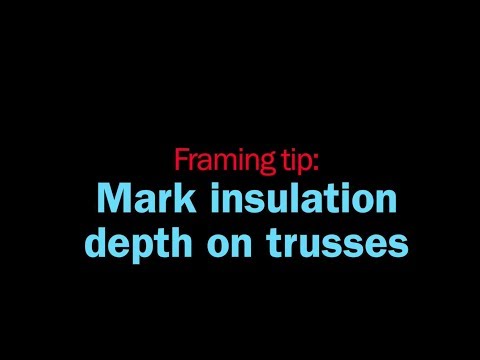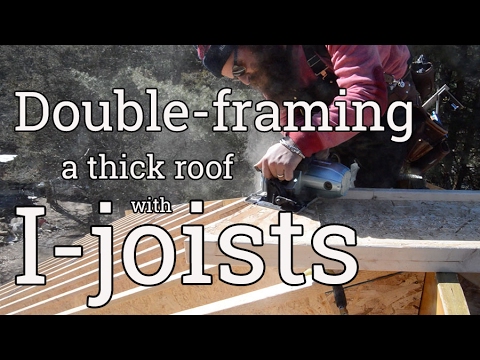
Better insulation, drier walls, lower HERS scores, and labor savings
Raised-heel trusses, also known as energy-heel trusses, deliver cost-effective energy performance, especially when used with continuous plywood or OSB sheathing.
Framing with raised-heel trusses and continuously sheathing exterior walls improves structural and energy performance and offers many savings that benefit both the builder and the homeowner.
What is a raised-heel truss?
A raised-heel truss is identical to a conventional truss except for one difference: it is raised higher, with a “heel” that extends up from the top of the wall and elevates the truss at the building’s edges. Raising the truss higher has two big advantages: it greatly simplifies attic ventilation, and it leaves ample room for insulation above exterior wall top plates.

A systems-approach improves more than the sum of the parts

A construction system that uses raised-heel trusses in combination with exterior walls that are fully sheathed with plywood or OSB offers many ways to save and improves structural and energy performance, benefiting builder and homeowner alike.
Raised-heel trusses are most effective when used as part of a framing system that also includes continuous sheathing with wood structural panels on all exterior walls of the home.
By installing plywood or OSB sheathing on the walls that overlaps the heels of the trusses, builders save time and resources and create a stronger, more resilient building envelope.
- Continuous wood structural panel sheathing across top plates eliminates the need for blocking and minimizes air infiltration.
- Overlapping the truss heels with continuous plywood or OSB sheathing creates a stronger building envelope by enhancing the connection between the wall and roof.
- Continuous sheathing reduces air movement through the edges of attic insulation, so that the insulation value isn’t compromised.
- Energy code allows for reduced ceiling insulation because its effectiveness is uncompromised by compression over the top plates.
- Sheathing must be wood structural panels manufactured to PS 1 or PS 2 standards meeting Section R602.1.8 of the 2015 IRC.
- Raised-heel trusses 9-1/4 to 15-1/4 inches in depth.
- Building is designed in accordance with the IRC.
- Ventilation eave baffles, if needed, for air flow.

Easy to build with
Raised-heel trusses are installed the same as conventional trusses. Builders don’t need special tools or know-how to build with them. This similarity to conventional trusses makes implementing raised-heel trusses into building plans an easy, straightforward process.
Overlapping heels of trusses with wall sheathing saves money
Overlapping the heels of raised-heel trusses with continuous plywood or OSB sheathing can cut costs. Without the continuous sheathing, raised-heel trusses require blocking at truss ends above all braced wall panels.
But sheathing with plywood or OSB can completely eliminate code-required blocking, saving time and expense provided that the requirements in Section R602.10.8.2 of the 2015 International Residential Code (IRC) are met.
Savings on insulation costs
Raised-heel trusses do not compress the attic insulation over the top plate, which compromises the insulation value. When builders use these trusses, the energy code allows for use of less insulation for the entire ceiling system.
For example, in colder climate zones where the energy code requires R49 ceiling insulation in attics, R38 insulation can instead be used, provided the truss heel is raised enough to prevent compression of the insulation.
Less insulation for the entire ceiling system means savings on materials for the builder—and even with the reduced insulation, the home is still more energy-efficient and comfortable than one built with conventional trusses, and deeper insulation that is compressed at the eaves.
Meet building codes and enhance structural performance
A wall system combining raised-heel trusses with overlapping continuous wood structural panel sheathing has a hidden structural advantage over conventional wall-to-truss connections. Walls connected with conventional means like toenailing cannot compete in structural integrity and resilience to walls constructed with continuous wood structural panel sheathing overlapping truss heels.
With this system, the wall-to-truss connection is greatly enhanced, resulting in superior overall load path, including better resistance to lateral forces like winds or seismic activity.
Improved HERS scores
One of the biggest benefits of raised-heel trusses is a lower Home Energy Rating (HERS) index for the home, which means lower utility bills for the customer and easier code compliance (under Section R406, Energy Rating Index Compliance Alternative, of the 2015 International Energy Conservation Code, or IECC). HERS index ratings are typically 4 to 6 points lower for homes with raised-heel trusses*.
This is because raised-heel trusses provide improved access to hard-to-insulate areas, permit full depth insulation throughout the attic, and result in superior energy efficiency. The resulting lower HERS ratings make complying with the energy code easier and less costly.
*Note: Average energy savings of a raised-heel truss home compared to a home with standard roof trusses, insulated in accordance with Table R402.1.2 and Section R402.2.1 of the 2015 IECC. Energy savings based on an analysis of homes located in climate zones 2–8.
A more comfortable interior
Savings aside, a home built with raised-heel trusses is simply more comfortable to live in. Improved ceiling insulation eliminates the cold spots at the top of exterior walls that conventional trusses create, resulting in a more stable temperature and a more comfortable home.
Design considerations
Raised-heel trusses are most effective when used as part of a framing system that also includes continuous sheathing with wood structural panels on all exterior walls of the home. Raised-Heel Trusses for Efficient, Cost-Effective, Comfortable Homes, Form R330, provides guidance on building with raised-heel trusses for designs that meet these categories:
- Basic wind speeds of 110 mph or less (Ultimate design wind speed, VULT, of 140 mph or less)
- Seismic Design Category A, B, or C for detached one- and two-family dwellings
- Seismic Design Category A or B for townhouses
- Raised-heel trusses 9-1/4 to 15-1/4 inches in depth
For other wind or seismic categories or raised-heel truss depths, consult the IRC, IBC or APA System Report SR-103: Use of Wood Structural Panels for Energy-Heel Trusses.
—This article is from APA, The Engineered Wood Association.
